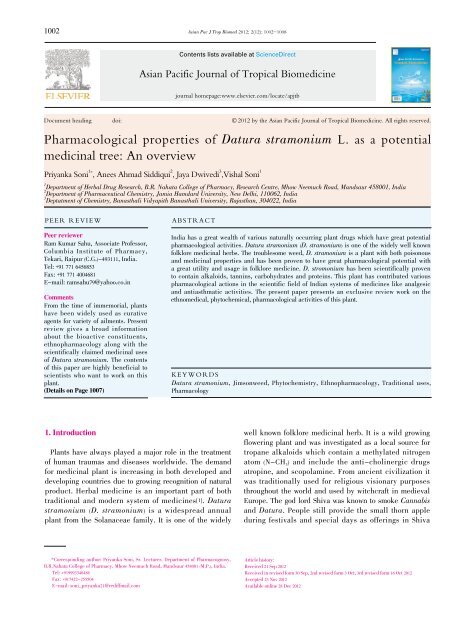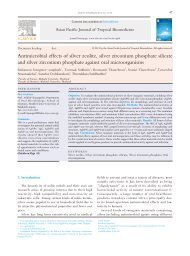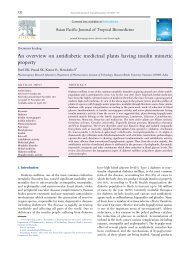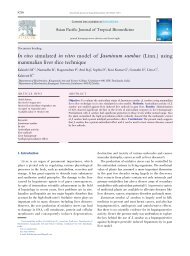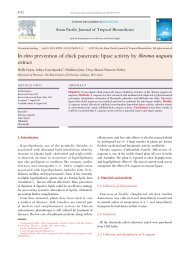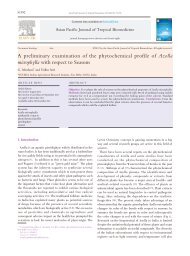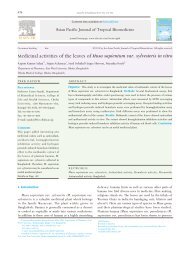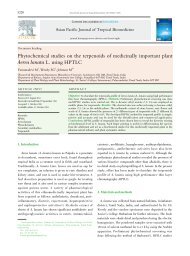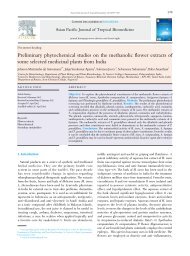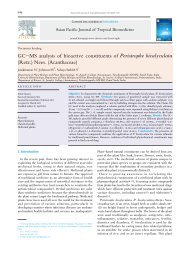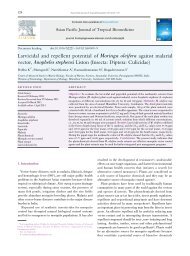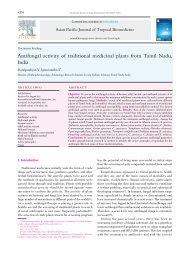Pharmacological properties of Datura stramonium L. as a - Apjtb.com
Pharmacological properties of Datura stramonium L. as a - Apjtb.com
Pharmacological properties of Datura stramonium L. as a - Apjtb.com
You also want an ePaper? Increase the reach of your titles
YUMPU automatically turns print PDFs into web optimized ePapers that Google loves.
1002 Asian Pac J Trop Biomed 2012; 2(12): 1002-1008<br />
Asian Pacific Journal <strong>of</strong> Tropical Biomedicine<br />
journal homepage:www.elsevier.<strong>com</strong>/locate/apjtb<br />
Document heading doi: 襃 2012 by the Asian Pacific Journal <strong>of</strong> Tropical Biomedicine. All rights reserved.<br />
<strong>Pharmacological</strong> <strong>properties</strong> <strong>of</strong> <strong>Datura</strong> <strong>stramonium</strong> L. <strong>as</strong> a potential<br />
medicinal tree: An overview<br />
Priyanka Soni 1* , Anees Ahmad Siddiqui 2 , Jaya Dwivedi 3 ,Vishal Soni 1<br />
1 Department <strong>of</strong> Herbal Drug Research, B.R. Nahata College <strong>of</strong> Pharmacy, Research Centre, Mhow Neemuch Road, Mandsaur 458001, India<br />
2 Department <strong>of</strong> Pharmaceutical Chemistry, Jamia Hamdard University, New Delhi, 110062, India<br />
3 Deptatment <strong>of</strong> Chemistry, Ban<strong>as</strong>thali Vidyapith Ban<strong>as</strong>thali University, Raj<strong>as</strong>than, 304022, India<br />
PEER REVIEW ABSTRACT<br />
Peer reviewer<br />
Ram Kumar Sahu, Associate Pr<strong>of</strong>essor,<br />
Columbia Institute <strong>of</strong> Pharmacy,<br />
Tekari, Raipur (C.G.)-493111, India.<br />
Tel: +91 771 6456853<br />
Fax: +91 771 4004681<br />
E-mail: ramsahu79@yahoo.co.in<br />
Comments<br />
From the time <strong>of</strong> immemorial, plants<br />
have been widely used <strong>as</strong> curative<br />
agents for variety <strong>of</strong> ailments. Present<br />
review gives a broad information<br />
about the bioactive constituents,<br />
ethnopharmacology along with the<br />
scientifically claimed medicinal uses<br />
<strong>of</strong> <strong>Datura</strong> <strong>stramonium</strong>. The contents<br />
<strong>of</strong> this paper are highly beneficial to<br />
scientists who want to work on this<br />
plant.<br />
(Details on Page 1007)<br />
1. Introduction<br />
Plants have always played a major role in the treatment<br />
<strong>of</strong> human traum<strong>as</strong> and dise<strong>as</strong>es worldwide. The demand<br />
for medicinal plant is incre<strong>as</strong>ing in both developed and<br />
developing countries due to growing recognition <strong>of</strong> natural<br />
product. Herbal medicine is an important part <strong>of</strong> both<br />
traditional and modern system <strong>of</strong> medicines[1]. <strong>Datura</strong><br />
<strong>stramonium</strong> (D. <strong>stramonium</strong>) is a widespread annual<br />
plant from the Solanaceae family. It is one <strong>of</strong> the widely<br />
*Corresponding author: Priyanka Soni, Sr. Lecturer, Department <strong>of</strong> Pharmacognosy,<br />
B.R.Nahata College <strong>of</strong> Pharmacy, Mhow Neemuch Road, Mandsaur 458001 (M.P.), India.<br />
Tel: +919993346486<br />
Fax: +917422-255504<br />
E-mail: soni_priyanka21@rediffmail.<strong>com</strong><br />
Contents lists available at ScienceDirect<br />
India h<strong>as</strong> a great wealth <strong>of</strong> various naturally occurring plant drugs which have great potential<br />
pharmacological activities. <strong>Datura</strong> <strong>stramonium</strong> (D. <strong>stramonium</strong>) is one <strong>of</strong> the widely well known<br />
folklore medicinal herbs. The troublesome weed, D. <strong>stramonium</strong> is a plant with both poisonous<br />
and medicinal <strong>properties</strong> and h<strong>as</strong> been proven to have great pharmacological potential with<br />
a great utility and usage in folklore medicine. D. stromonium h<strong>as</strong> been scientifically proven<br />
to contain alkaloids, tannins, carbohydrates and proteins. This plant h<strong>as</strong> contributed various<br />
pharmacological actions in the scientific field <strong>of</strong> Indian systems <strong>of</strong> medicines like analgesic<br />
and anti<strong>as</strong>thmatic activities. The present paper presents an exclusive review work on the<br />
ethnomedical, phytochemical, pharmacological activities <strong>of</strong> this plant.<br />
KEYWORDS<br />
<strong>Datura</strong> <strong>stramonium</strong>, Jimsonweed, Phytochemistry, Ethnopharmacology, Traditional uses,<br />
Pharmacology<br />
well known folklore medicinal herb. It is a wild growing<br />
flowering plant and w<strong>as</strong> investigated <strong>as</strong> a local source for<br />
tropane alkaloids which contain a methylated nitrogen<br />
atom (N-CH 3) and include the anti-cholinergic drugs<br />
atropine, and scopolamine. From ancient civilization it<br />
w<strong>as</strong> traditionally used for religious visionary purposes<br />
throughout the world and used by witchcraft in medieval<br />
Europe. The god lord Shiva w<strong>as</strong> known to smoke Cannabis<br />
and <strong>Datura</strong>. People still provide the small thorn apple<br />
during festivals and special days <strong>as</strong> <strong>of</strong>ferings in Shiva<br />
Article history:<br />
Received 21 Sep 2012<br />
Received in revised form 30 Sep, 2nd revised form 3 Oct, 3rd revised form 16 Oct 2012<br />
Accepted 23 Nov 2012<br />
Available online 28 Dec 2012
icons at temples. An extract made from the leaves is taken<br />
orally for the treatment <strong>of</strong> <strong>as</strong>thma and sinus infections,<br />
and stripped bark are applied externally to treat swellings,<br />
burns and ulcers. The incidence <strong>of</strong> D. <strong>stramonium</strong> poisoning<br />
is sporadic with a cluster <strong>of</strong> poisoning c<strong>as</strong>es in the 1990s<br />
and 2000s, the United States media reported some c<strong>as</strong>es<br />
occurring mostly among adolescents and young adults dying<br />
or be<strong>com</strong>ing seriously ill from ingesting. Some medicinal<br />
uses <strong>of</strong> the plant are its anti-inflammatory property <strong>of</strong><br />
all parts <strong>of</strong> the plant, stimulation <strong>of</strong> the central nervous<br />
system, respiratory decongestion, treatment <strong>of</strong> dental and<br />
skin infections, alopecia and in the treatment <strong>of</strong> toothache.<br />
It is a hallucinogenic plant that causes serious poisoning.<br />
Consumption <strong>of</strong> any part <strong>of</strong> the plant may result in a<br />
severe anticholinergic reaction that may lead to toxicity<br />
and occ<strong>as</strong>ionally cause diagnostic difficulties. C<strong>as</strong>es <strong>of</strong><br />
poisoning have been reported after eating the berries.<br />
Death may occur from heart failure after ingesting 125<br />
seeds, because the seeds contain the highest concentration<br />
and h<strong>as</strong> a rapid onset <strong>of</strong> action, thus may be potentially<br />
useful <strong>as</strong> an alternative to atropine for the treatment <strong>of</strong> the<br />
muscarinic symptoms <strong>of</strong> organophosphate toxicity and some<br />
<strong>of</strong> central anticholinergic effects. The wide distribution,<br />
the strong toxicity and the potential for occurrence in<br />
foodstuffs are responsible for the numerous incidents in<br />
humans[2]. <strong>Datura</strong> genus distributes over tropical and warm<br />
temperate regions <strong>of</strong> the world. About ten species <strong>of</strong> <strong>Datura</strong><br />
are found, <strong>of</strong> which <strong>Datura</strong> anoxia and D. stromonium are<br />
most important drug plants. <strong>Datura</strong> h<strong>as</strong> long been known<br />
<strong>as</strong> a medicinal plant and <strong>as</strong> a plant hallucinogen all over<br />
the world. Pre-historic use <strong>of</strong> <strong>Datura</strong> in medicinal and<br />
ceremonial rituals could be observed in aboriginal in Indian<br />
sub-continent[3]. The therapeutic activities <strong>of</strong> most plants<br />
are due to the presence <strong>of</strong> one or more <strong>of</strong> such <strong>com</strong>ponents<br />
like alkaloids, tannins, saponins and cardiac glycosides.<br />
The phytochemical screening revealed the presence <strong>of</strong><br />
saponins, tannins, steroids, alkaloids, flavonoids, phenols<br />
and glycosides[4].Atropine and scopolamine are <strong>com</strong>petitive<br />
antagonists <strong>of</strong> muscarinic cholinergic receptors and are<br />
central nervous system depressants. All parts <strong>of</strong> the plant<br />
are toxic, but the highest amount <strong>of</strong> alkaloids is contained<br />
in the ripe seeds[4,5]. Many c<strong>as</strong>es <strong>of</strong> accidental poisoning by<br />
D. <strong>stramonium</strong> have been reported when these plants were<br />
eaten accidentally[6].<br />
Figure 1. <strong>Datura</strong> <strong>stramonium</strong>.<br />
a: <strong>Datura</strong> plant (leaves and flowers); b: D. <strong>stramonium</strong> fruit; c: D. <strong>stramonium</strong> flower.<br />
Priyanka Soni et al./Asian Pac J Trop Biomed 2012; 2(12): 1002-1008 1003<br />
2. Regional and other names<br />
Sanskrit: Umatta-virkshaha<br />
English: Thornapple<br />
Hindi: Sadah-<strong>Datura</strong>, Safed <strong>Datura</strong><br />
Tamil: Umatai<br />
Arab: Jonz-m<strong>as</strong>al<br />
Gujrat: Dhatoria<br />
Bengali: Dhattura<br />
Malayalam: Maraummam<br />
Marathi: Kanaka<br />
3. Scientific cl<strong>as</strong>sification <strong>of</strong> D. stromonium<br />
Kingdom: Plantae<br />
Division: Magnoliophyta<br />
Cl<strong>as</strong>s: Magnoliopsida<br />
Order: Solanales<br />
Family: Solanaceae<br />
Genus: <strong>Datura</strong><br />
Species: <strong>Datura</strong> stromonium<br />
4. Botanical description<br />
4.1. Plant appearance<br />
D. <strong>stramonium</strong> is an annual plant (Figure 1). The stem is<br />
herbaceous, branched and glabrous or only lightly hairy. By<br />
cultivation the plant reaches a height <strong>of</strong> about one meter[7,8].<br />
The branching stems are spreading, leafy, stout, erect, smooth<br />
and pale yellowish green in color, branching repeatedly in<br />
a forked manner. Leaves are hairy, big, simple dentate, oval<br />
glabrous, apposite veins <strong>of</strong> leaves are pale black, stalked,<br />
4-6 inch long, ovate and pale green. The upper surface is<br />
dark and grayish-green, generally smooth, the under surface<br />
paler, and when dried, minutely wrinkled (Figure 1a). D.<br />
<strong>stramonium</strong> bears funnel shaped, white or purple coloured<br />
flowers, with 5 stamens and superior ovary (Figure 1b). The<br />
average length <strong>of</strong> flower is about 3 inches. The calyx is long,<br />
tubular and somewhat a swollen below and very sharply five<br />
angled surmounted by five sharp teeth. Corolla is funnel<br />
shaped. Stem stalk is pale blue or greenish white. Seeds<br />
A B C
1004<br />
are black, kidney shape and flat[9,10]. Fruits are <strong>as</strong> large <strong>as</strong><br />
walnuts and full <strong>of</strong> thorns (hence the English name “thorn<br />
apple”) (Figure 1c). The plant is strong narcotic, but h<strong>as</strong> a<br />
peculiar action on the human which renders it very valuable<br />
<strong>as</strong> medicines. The whole plant is poisonous and the seeds<br />
are the most active; neither dying nor boiling destroys the<br />
poisonous <strong>properties</strong>. The symptoms <strong>of</strong> acute Jimsonweed<br />
poisoning included dryness <strong>of</strong> the mouth and extreme<br />
thirst, dryness <strong>of</strong> the skin, pupil dilate ion, impaired vision,<br />
urinary retention, rapid heartbeat, confusion, restlessness,<br />
hallucinations, and loss <strong>of</strong> consciousness[2].<br />
4.2. Distributions<br />
D. stromonium is probably originated in C<strong>as</strong>pian Sea<br />
territories and spreaded to Europe in the first century. At<br />
present it grows in w<strong>as</strong>te places in Europe, Asia, America<br />
and South Africa. D. stromonium is cultivated in Germany,<br />
France, Hungary, South America and throughout the<br />
world[8].<br />
4.3. Cultivation and collection<br />
Thorn apple is e<strong>as</strong>ily cultivated, growing well in open,<br />
sunny situation. It flourishes in most moderately good soil<br />
but grows best in calcareous rich soil, or in a good sandy<br />
loam, with leaf mould added. Seeds are sown in open in<br />
May, in drill 3 feet apart, barely covered. Sown thinly, <strong>as</strong><br />
the plants attain a good size and grow freely from seed.<br />
Thin out the young plants to a distance <strong>of</strong> 12 to 15 inches<br />
between each plant in the drill. The soil should be kept free<br />
from weeds in the early stages. If the summer is hot and<br />
dry, give a mulching <strong>of</strong> rotted cow-manure. If grown for leaf<br />
crop, the capsule should be picked <strong>of</strong>f <strong>as</strong> soon <strong>as</strong> formed,<br />
<strong>as</strong> in a wind the spines tear the leaves. In August the plant<br />
reaches to a hight <strong>of</strong> 1 meter and bears flowers and fruits.<br />
In the end <strong>of</strong> August stems with leaves and flowering tops are<br />
collected and dried <strong>as</strong> soon <strong>as</strong> possible at 45 °C to 50 °C. The<br />
leaves should be gathered when the plant is in full bloom<br />
and carefully dried. They are generally harvested in late<br />
summer. In August, the crop is cut by the sickle on a fine<br />
day in the morning, after the sun h<strong>as</strong> dried <strong>of</strong>f the dew, and<br />
the leaves are stripped from the stem, dried carefully <strong>as</strong><br />
quickly <strong>as</strong> possible[8-10].<br />
5. Ethanomedical uses<br />
Plant derived drugs <strong>com</strong>e into use in the modern medicine<br />
through the uses <strong>of</strong> plant material <strong>as</strong> indigenous cure in<br />
folklore or traditional systems <strong>of</strong> medicine. The leaves<br />
<strong>of</strong> D. stromonium L. are used for the relief <strong>of</strong> headache<br />
and vapours <strong>of</strong> leaf infusion is used to relive the pain <strong>of</strong><br />
rheumatism and gout. The smoke from the burning leaf is<br />
inhaled for the relief <strong>of</strong> <strong>as</strong>thma and bronchitis. European<br />
remedy <strong>of</strong> D. stromonium for haemorrhoid is to steam the<br />
part over boiling water containing leaf. The fruit juice is<br />
Priyanka Soni et al./Asian Pac J Trop Biomed 2012; 2(12): 1002-1008<br />
applied to the scalp for the treatment <strong>of</strong> falling hair and<br />
dandruff. It is also applied to smooth painful wounds<br />
and sores. Seeds and leaves <strong>of</strong> D. stromonium were used<br />
to sedate hysterical and psychotic patients, also to treat<br />
insomnia. D. stromonium w<strong>as</strong> used <strong>as</strong> hallucinogenic<br />
drug. It is also used to relax the smooth muscles <strong>of</strong> the<br />
bronchial tube and <strong>as</strong>thmatic bronchial sp<strong>as</strong>m. It w<strong>as</strong><br />
reported that D. stromonium w<strong>as</strong> used internally to treat<br />
madness, epilepsy and depression. Externally it forms the<br />
b<strong>as</strong>is <strong>of</strong> ointment for burns and rheumatism[12]. It is also<br />
used in the treatment <strong>of</strong> parkinsonism and hemorrhoids. Its<br />
leaves, applied after ro<strong>as</strong>ting, are useful in relieving pain.<br />
The bitter narcotic plant relieves pain and encourages the<br />
healing process. The seeds <strong>of</strong> the plant are medicinally the<br />
most active. Externally, the plant is used <strong>as</strong> a poultice in<br />
treating fistul<strong>as</strong>, abscesses wounds and severe neuralgia.<br />
Scopolamine is also found in the plant, which makes it<br />
a potent cholinergic-blocki hallucinogen that h<strong>as</strong> been<br />
used to calm schizoid patients. Its leaves, containing<br />
hyoscyamine and atropine, can be used <strong>as</strong> an immensely<br />
powerful mind-altering drug. The seeds <strong>of</strong> <strong>Datura</strong> are<br />
analgesic, anthelmintic and anti-inflammatory and <strong>as</strong> such,<br />
they are used in the treatment <strong>of</strong> stomach and intestinal<br />
pain that results from worm infestation, toothache, and fever<br />
from inflammation. The juice <strong>of</strong> its fruit is applied to the<br />
scalp, to treat dandruff and falling hair. The growing plant<br />
works <strong>as</strong> an insect repellant, which protects neighboring<br />
plants from insects[2]. D. stromonium is mostly used <strong>as</strong><br />
anthelmintics and antipar<strong>as</strong>itic in Marche, Abruzzo and<br />
Latium. Records <strong>of</strong> continued use <strong>of</strong> the plant in these<br />
sectors w<strong>as</strong> collected from farmers and shepherds (mostly<br />
old people)[4,13].<br />
6. Phytochemicals<br />
The major tropane alkaloids hyoscyamine and scopolamine<br />
and several minor tropane alkaloids have been identified<br />
in <strong>Datura</strong> species. Typical examples <strong>of</strong> minor alkaloids in<br />
D. <strong>stramonium</strong> are tigloidin, aposcopolamine, apoatropin,<br />
hyoscyamine N-oxide and scopolamine N-oxide17-20. 6<br />
覾-ditigloyloxytropane and 7-hydroxyhyoscyamine are<br />
reported for the first time in this species[2].<br />
Distribution <strong>of</strong> hyoscyamine and scopolamine in D.<br />
stromonium w<strong>as</strong> studied. The production <strong>of</strong> hycyamine and<br />
scopolamine in D. stromonium h<strong>as</strong> been investigated in the<br />
different plant parts, at different stages <strong>of</strong> their life cycle.<br />
The maximum contents were found in the stems and leaves<br />
<strong>of</strong> young plants, hyocyamine being always the predominate<br />
<strong>com</strong>ponent. These <strong>com</strong>pounds were included in many<br />
pharmacopie<strong>as</strong> because <strong>of</strong> their anticholinergic activities[4].<br />
D. stromonium contain variety <strong>of</strong> alkaloids including<br />
atropine, hyoscamine and scopolamine[14].<br />
Sixty-four tropane alkaloids have been detected from<br />
D. <strong>stramonium</strong>. Two new tropane alkaloids, 3-phenylacetoxy-6,<br />
7-epoxynortropane and 7-hydroxyapoatropine were tentatively<br />
identified. The alkaloids scopoline, 3-(hydroxyacetoxy) tropane,
3-hydroxy-6-(2-methylbutyryloxy) tropane, 3覾-tigloyloxy-6hydroxytropane,<br />
3, 7-dihydroxy-6-tigloyloxytropane, 3-tigloyloxy-<br />
6-propionyloxytropane, 3 phenylacetoxy-6,7-epoxytropane,<br />
3-phenylacetoxy-6-hydroxytropane, aponor scopolamine, 3覾, 6<br />
覾-ditigloyloxytropane and 7-hydroxyhyoscyamine are reported<br />
for the first time for this species[15]. Other alkaloids found in<br />
D. <strong>stramonium</strong> include[16]: Hygrine, 3á, 6覾-Ditigloyloxy-<br />
7-hydroxytropane, 6-Hydroxyhyoscyamine, Pseudotropine,<br />
3á-Tigloyloxytropane, Hydroxy-6-tigloyloxytropane,<br />
Phenylacetoxytropane, 3-Tigloyloxy-6-(2-methylbutyryloxy) tropane,<br />
Hyoscyamine, 3-Tigloyloxy-6-isovaleroyloxy-7-hydroxytropane,<br />
Scopolamine, Tropinone, Scopine, 6-Hydroxyacetoxytropane, 3,6-<br />
Diacetoxytropane, 3-Tigloxyloxy-6-acetoxytropane, 3-Tigloyloxy-<br />
2-methylbutyryloxytropane, 3á, 6覾-Ditiglotoxytropane, 3-Acetoxy-<br />
6-isobutyryloxytropan, 3-(2-Phenylpropionyloxy) tropane, Littorine,<br />
6-Hydroxyapoatropine, 3覾, 6覾-Ditigloyloxy-7-hydroxytropane,<br />
3-Tropoyloxy-6-acetoxytropane, 3,6-Dihydroxytropane, 3<br />
覾-Tigloyloxytropane, 3-Tigloyloxy-6-propionyloxy-7-<br />
hydroxytropane, 3á-Apotropoyloxytropane, Aposcopolamine,<br />
3覾, 6覾-Ditigloyloxytropane, 3-(3’-Acetoxytropoyloxy)<br />
tropane, 3á-Tigloyloxy-6-hydroxytropane, Tropine,<br />
3-Acetoxytropane, 3-Hydroxy-6-acetoxytropane, 3-Hydroxy-6methylbutyryloxytropane,<br />
3-Tigloloxy-6-isobutyryloxytropane,<br />
Aponorscopolamine, 7-Hydroxyhyoscyamine, Meteloidine, 3覾, 6覾<br />
-Ditigloyloxytropane.<br />
The phytochemical analysis <strong>of</strong> the plant revealed that D.<br />
<strong>stramonium</strong> contained saponins, tannins and alkaloids and<br />
glycosides. The secondary metabolites identified in the plant<br />
materials in the study <strong>of</strong> Banso A and Adeyemo S showed<br />
antimicrobial activity[17].<br />
7. <strong>Pharmacological</strong> activity<br />
7.1. Anti<strong>as</strong>thmatic activity<br />
D. stromonium in <strong>as</strong>thma treatment and possible effects<br />
on prenatal development w<strong>as</strong> studied. Exposure <strong>of</strong> the foetus<br />
to D. stromonium when a mother use it for <strong>as</strong>thma, will<br />
cause a continuous rele<strong>as</strong>e <strong>of</strong> acetylcholine, resulting in the<br />
desensitization <strong>of</strong> nicotinic receptors, this could ultimately<br />
result in permanent damage to the foetus. Therefore we<br />
conclude that this African herbal remedy should be used<br />
with caution during pregnancy[18].<br />
7.2. Anticholinergic activity<br />
The alkaloids found in D. <strong>stramonium</strong>, are organic esters<br />
used clinically <strong>as</strong> anticholinergic agents. Jimson weed h<strong>as</strong><br />
been reported <strong>as</strong> a drug <strong>of</strong> abuse and h<strong>as</strong> been involved in<br />
the accidental poisoning <strong>of</strong> humans and animals. Symptoms<br />
<strong>of</strong> acute jimson weed poisoning included dryness <strong>of</strong> the<br />
mouth and extreme thirst, dryness <strong>of</strong> the skin, pupil<br />
dilation and impaired vision, urinary retention, rapid<br />
heartbeat, confusion, restlessness, hallucinations, and loss<br />
<strong>of</strong> consciousness. The anticholinergic syndrome results<br />
Priyanka Soni et al./Asian Pac J Trop Biomed 2012; 2(12): 1002-1008 1005<br />
from the inhibition <strong>of</strong> central and peripheral muscarinic<br />
neurotransmission[19-21].<br />
7.3. Acaricidal, repellent and oviposition deterrent <strong>properties</strong><br />
The ethanol extracts obtained from both leaf and seed<br />
in D. stromonium (Solanaceae) were investigated for<br />
acaricidal, repellent and oviposition deterrent <strong>properties</strong><br />
against adult two-spotted spider mites (T. urticae Koch)<br />
(Acari: Tetranychidae) under laboratory conditions. Leaf and<br />
seed extracts, which were applied in 167.25 and 145.75 g/<br />
L concentrations, respectively (using a Petri leaf disc-spray<br />
tower method), caused 98% and 25% mortality among spider<br />
mite adults after 48 h. These results suggest that D. <strong>stramonium</strong><br />
extracts could be used to manage the two-spotted spider<br />
mite[22].<br />
7.4. Antimicrobial Activity<br />
The methanol extracts <strong>of</strong> D. stromonium and <strong>Datura</strong> inoxia<br />
showed activity against Gram positive bacteria in a dose<br />
dependent manner. Little or no antimicrobial activity w<strong>as</strong><br />
found against Escherichia coli and Psuedomon<strong>as</strong> aeruginosa[23].<br />
The anti-microbial activity <strong>of</strong> <strong>com</strong>bined crude ethanolic<br />
extract <strong>of</strong> D. stromonium, Terminalia arjuna and Withania<br />
somnifera in cup plate diffusion method for antibacterial and<br />
antifungal activity. The extracts were subjected to screening to<br />
detect potential antimicrobial activity against Staphylococcus<br />
aureus, Bacillus subtilus, Escherichia coli, Klebsiella<br />
pneumoniae, Micrococcus luteus and Candida albicans with<br />
<strong>com</strong>pare Cipr<strong>of</strong>loxacin standard drug[24].<br />
7.5. Anticancer activity<br />
An integrated approach is needed to manage cancer using<br />
the growing body <strong>of</strong> knowledge gained through scientific<br />
developments. Thousands <strong>of</strong> herbal and traditional <strong>com</strong>pounds<br />
are being screened worldwide to validate their use <strong>as</strong> anticancerous<br />
drugs. D. stromonium in therapeutic dose <strong>of</strong> 0.05-<br />
0.10 g w<strong>as</strong> used to cure cancer. Likely unsafeproduce vomiting,<br />
hypertension, loss <strong>of</strong> consciousness may lead to <strong>com</strong>a but may<br />
interact with anti-cholinergic drugs[25].<br />
7.6. Antiinflamatory activity<br />
Coriandrum sativum (C. sativum), D. stromonium and<br />
Azadirachta indica (A. indica) are traditionally used in<br />
treatment <strong>of</strong> inflammation. Ethanolic extracts <strong>of</strong> fruits <strong>of</strong> C.<br />
sativum, leaves <strong>of</strong> D. stromonium. Ethanolic extracts <strong>of</strong> fruits<br />
<strong>of</strong> C. sativum, leaves <strong>of</strong> D. stromonium and A. indica were<br />
subjected to preliminary screening for anti-inflammatory<br />
activity in albino rats. All ethanolic extracts exhibited<br />
significant anti-inflammatory activity <strong>com</strong>parable to the<br />
standard drug dicl<strong>of</strong>enac sodium against carrageenan induced<br />
rat paw edema method. Among these plant A. indica showed<br />
maximum anti-inflammatory activity per hour[26].
1006<br />
7.7. Larvicidal and mosquito repellent activities<br />
Ethanolic extracts <strong>of</strong> leaves <strong>of</strong> D. stromonium were<br />
evaluated for larvicidal and mosquito repellent activities<br />
against Aedes aegypti, Anopheles stephensi and Culex<br />
quinquef<strong>as</strong>ciatus. The LD 50 values for larvicidal activity were<br />
found to be 86.25, 16.07 and 6.25 mg/L against Aedes aegypti,<br />
Anopheles stephensi and Culex quinquef<strong>as</strong>ciatus respectively.<br />
The ethanolic leaves extract <strong>of</strong> D. stromonium provided<br />
<strong>com</strong>plete protection time (mosquito repellency) <strong>of</strong> 2.7, 71.7<br />
and 117.7 min against Aedes aegypti, Anopheles stephensi and<br />
Culex quinquef<strong>as</strong>ciatus at higher concentration (1%)[27].<br />
7.8. Pesticide toxicity<br />
Extract <strong>of</strong> D. stromonium w<strong>as</strong> effective in countering the<br />
toxicity <strong>of</strong> the cypermethrin pesticide toxicity[28].<br />
7.9. Antifungal activity<br />
Antifungal activity <strong>of</strong> a concoction brewed from D.<br />
stromonium, Calotropis gigantea, A. indica (neem) and cow<br />
manure (T1) followed by methanol-water (70/30 v/v) extracts<br />
<strong>of</strong> D. stromonium, Calotropis gigantea and A. indica T2<br />
against Fusarium mangiferae. The study proved that the<br />
concoction-brewed <strong>com</strong>post T1 is effective, inexpensive,<br />
e<strong>as</strong>y to prepare and constitutes a sustainable and ec<strong>of</strong>riendly<br />
approach to control floral malformation in mango<br />
when it is sprayed at bud break stage and again at fruit set<br />
stage[29].<br />
7.10. Vibriocidal activity<br />
A simple in vitro screening <strong>as</strong>say w<strong>as</strong> employed for the<br />
standard strain <strong>of</strong> Vibrio cholerae, 12 isolates <strong>of</strong> Vibrio<br />
cholerae non-O1, and Vibrio parahaemolyticus. Aqueous<br />
and organic solvent extracts <strong>of</strong> different parts <strong>of</strong> the plants<br />
were investigated by using the disk diffusion method.<br />
Extracts from 16 medicinal plants were selected on account<br />
<strong>of</strong> the reported traditional uses for the treatment <strong>of</strong> cholera<br />
and g<strong>as</strong>trointestinal dise<strong>as</strong>es, and they were <strong>as</strong>sayed for<br />
vibriocidal activitie. The results indicated that Lawsonia<br />
inermis, Saraca indica, Syzygium cumini, Terminalia<br />
belerica, Allium sativum, and D. stromonium served <strong>as</strong><br />
broad-spectrum vibriocidal agents[30].<br />
7.11. Toxicity studies<br />
Toxicity studies <strong>of</strong> ethanol extract <strong>of</strong> the leaves <strong>of</strong> D.<br />
stromonium in rats. Two doses <strong>of</strong> 50 and 200 mg/kg <strong>of</strong><br />
the extract were administered to the rats for five weeks.<br />
Parameters studied were the indices <strong>of</strong> liver and kidney<br />
function and some biochemical and haematological<br />
parameters. Feed intake, final body weight, serum AST,<br />
ALT, billurubin, total protein, urea and the electrolyte<br />
studied were not affected by the extract administration.<br />
Priyanka Soni et al./Asian Pac J Trop Biomed 2012; 2(12): 1002-1008<br />
Serum creatinine levels were however significantly<br />
raised in the rats administered with ethanol extract at<br />
the dose <strong>of</strong> 200 mg/kg body weight. The biochemical and<br />
haematological parameters were also affected[31]. The<br />
effects <strong>of</strong> acute, subacute and chronic administration<br />
<strong>of</strong> alkaloids atropine and scopolamine, the main<br />
constituents <strong>of</strong> the active principle <strong>of</strong> D. stromonium,<br />
with toxic <strong>properties</strong>, were studied in male Albino Wistar<br />
rats. After acute i.p. administration <strong>of</strong> dose 100 mg/kg <strong>of</strong><br />
total alkaloids to the seeds <strong>of</strong> D. <strong>stramonium</strong>, there were<br />
no remarkable changes in general appearance and no<br />
deaths occurred in any experimental group. Twenty four<br />
hour after total alkaloids <strong>of</strong> seeds, a significant reduction<br />
in indices <strong>of</strong> liver, spleen brain and kidney function and<br />
some biochemical and haematological parameters were<br />
observed. The red blood cells, hematocrit, hemoglobin<br />
and white blood cells were significantly higher in the<br />
treated groups than the control group. Subacute study<br />
for four weeks showed no resulting mortality or signs<br />
<strong>of</strong> toxicity. In chronic study, the synthetic alkaloids<br />
administered i.p. at daily doses <strong>of</strong> 4.2 mg/kg <strong>of</strong> atropine<br />
and 1.6 mg/kg <strong>of</strong> scopolamine, did not produce death.<br />
However diarrhoea and hypoactivity were observed. The<br />
relative weight <strong>of</strong> liver w<strong>as</strong> significantly less than that <strong>of</strong><br />
the control group[32].<br />
7.12.Biopesticide with antifungal activity<br />
Biopesticides (leaf extracts) obtained from eight<br />
plants (Vitex negundo, Polyathia longifolia, Vinca<br />
rosea, Withania somnifera, Lawsonia inermis, Adhotoda<br />
zylanica, D. stromonium and Hyptis suaveolens) showed<br />
antifungal activities against the fungal pathogen<br />
(Fusarium oxysporum) <strong>of</strong> wilt <strong>of</strong> pigeon pea (Cajanus<br />
cajan L.). Both in vivo and in vitro higher concentration<br />
<strong>of</strong> ethanotic leaf extracts <strong>of</strong> all eight plants showed<br />
<strong>com</strong>plete inhibition in linear growth and sporulation in<br />
test fungi[33].<br />
7.13. Protective agent in severe organophosphate toxicity<br />
Treatment <strong>of</strong> patients following an organophosphate<br />
(OP) exposure can deplete a hospital’s entire supply<br />
<strong>of</strong> atropine. Given the possibility <strong>of</strong> multiple severe<br />
exposures after a terrorist attack using OP nerve agents,<br />
there exists a need for either greater atropine stores or<br />
the development <strong>of</strong> alternative antidotes. Jimsonweed (D.<br />
stromonium) contains atropine and other anticholinergic<br />
<strong>com</strong>pounds and is <strong>com</strong>mon and readily available. It is<br />
used recreationally for its central anticholinergic effects<br />
and is e<strong>as</strong>y to be made into an extract by boiling the<br />
crushed seeds. The extract h<strong>as</strong> rapid onset <strong>of</strong> effects and<br />
may be useful for treatment <strong>of</strong> OP poisoning. Pretreatment<br />
with D. stromonium extracts significantly incre<strong>as</strong>es<br />
survival following severe dichlorvos exposure[34].
8. Safety <strong>as</strong>pect<br />
Careful consideration <strong>of</strong> the toxicity <strong>of</strong> the plant is required<br />
before its use. Its ingestion induces characteristic symptoms.<br />
The mouth be<strong>com</strong>es dry, an intense thirst develops, the vision<br />
gets blurred with prominent mydri<strong>as</strong>is and the heart rate<br />
incre<strong>as</strong>es. This is followed by hallucinations, delirium, and loss<br />
<strong>of</strong> motor coordination which may lead to <strong>com</strong>mand ultimately to<br />
death by respiratory failure[35].<br />
9. Quantitative standards<br />
Dosage: 50-100 mg <strong>of</strong> dried leaf or the same amount in infusion.<br />
Total <strong>as</strong>h: Not more than 20.0%.<br />
Total alkaloid: Not less than 0.05% calculated <strong>as</strong> hyoscyamine.<br />
Foreign matter: Not more than 3.0% <strong>of</strong> stem having a diameter<br />
exceeding 5 mm.<br />
Acid insoluble <strong>as</strong>h: Not more than 4.0%.<br />
10. Conclusion<br />
Present review gives a broad information about the bioactive<br />
constituents, ethnopharmacology along with the scientifically<br />
claimed medicinal uses <strong>of</strong> D. <strong>stramonium</strong>. Several alkaloids,<br />
carbohydrates, fat, proteins and tannins have been reported to<br />
be present in different parts <strong>of</strong> D. <strong>stramonium</strong>. The plant shows<br />
various types <strong>of</strong> activities such <strong>as</strong> analgesic and anti<strong>as</strong>thamatic<br />
activity which may be due to the presence <strong>of</strong> the investigated<br />
active chemical constituents. The pharmacological studies so<br />
far have been performed in vitro and in vivo. Therefore, there is<br />
a need <strong>of</strong> investigation and quantification <strong>of</strong> phytoconstituents<br />
and pharmacological pr<strong>of</strong>ile.<br />
Conflict <strong>of</strong> interest statement<br />
We declare that we have no conflict <strong>of</strong> interest.<br />
Acknowledgements<br />
The authors thanks to Director B R Nahata College <strong>of</strong> Pharmacy,<br />
Mandsaur College <strong>of</strong> Pharmacy and Management for their kind<br />
support.<br />
Comments<br />
Background<br />
D. <strong>stramonium</strong> Linn is one <strong>of</strong> the widely well known<br />
folklore medicinal herb. D. <strong>stramonium</strong> is a plant with both<br />
poisonous and medicinal <strong>properties</strong> and h<strong>as</strong> been proven to<br />
have great pharmacological potential with a great utility and<br />
Priyanka Soni et al./Asian Pac J Trop Biomed 2012; 2(12): 1002-1008 1007<br />
usage <strong>as</strong> folklore medicine. The phytochemical investigations<br />
showed the presence <strong>of</strong> saponins, tannins, steroids, alkaloids,<br />
flavonoids, phenols and glycosides. Atropine and scopolamine<br />
are <strong>com</strong>petitive antagonists <strong>of</strong> muscarinic cholinergic receptors<br />
and are central nervous system depressants. The present<br />
paper presents an exclusive review work on the ethnomedical,<br />
phytochemical, pharmacological activities <strong>of</strong> this plant.<br />
Research frontiers<br />
From the time <strong>of</strong> immemorial, plants have been widely used<br />
<strong>as</strong> curative agents for varieties <strong>of</strong> ailments. Present study<br />
gives a broad information about the bioactive constituents,<br />
ethnopharmacology along with the scientifically claimed<br />
medicinal uses <strong>of</strong> D. <strong>stramonium</strong>.<br />
Related reports<br />
This review work may facilitate the enrichment <strong>of</strong> concept<br />
and the possible out<strong>com</strong>e from the use and consumption <strong>of</strong><br />
D. <strong>stramonium</strong>. The content is different from that <strong>of</strong> Maibam<br />
R<strong>as</strong>ila Devi1 et al and D<strong>as</strong> Sanjita et al 2012, who also described<br />
the neurotoxic <strong>properties</strong> and medicinal <strong>properties</strong> <strong>of</strong> D.<br />
<strong>stramonium</strong>.<br />
Innovations and breakthroughs<br />
Jimson weed is a plant with both poisonous and medicinal<br />
<strong>properties</strong> and h<strong>as</strong> been scientifically proven to have great<br />
pharmacological potential with a great utility and usage <strong>as</strong><br />
folklore medicine. This plant h<strong>as</strong> been used in curing different<br />
types <strong>of</strong> dise<strong>as</strong>es. The alkaloids isolated from the plants are<br />
also found to be toxic to the animals and 48 alkaloids have been<br />
determined in total.<br />
Applications<br />
This review papers advancing knowledge <strong>of</strong> D. <strong>stramonium</strong><br />
in respect to their ethnomedical, phytochemical, and<br />
pharmacological activities.<br />
This review paper provides <strong>com</strong>plete information <strong>of</strong> this plant<br />
regarding ethnomedical, phytochemical, and pharmacological<br />
activities to researchers.<br />
Peer review<br />
From the time <strong>of</strong> immemorial, plants have been widely used<br />
<strong>as</strong> curative agents for varieties <strong>of</strong> ailments. Present review<br />
gives a broad information about the bioactive constituents,<br />
ethnopharmacology along with the scientifically claimed<br />
medicinal uses <strong>of</strong> D. <strong>stramonium</strong>. The contents <strong>of</strong> paper are<br />
highly beneficial to scientists who want to work on this plant.<br />
References<br />
[1] Kirtikar JD, B<strong>as</strong>u BD. Indian medicinal plants. Allahabad: Lalit<br />
Mohan B<strong>as</strong>u; 1994, p. 1229-1231.<br />
[2] D<strong>as</strong> S, Kumar P, B<strong>as</strong>u SP. Review article on phytoconstituents and<br />
therapeutic potentials <strong>of</strong> <strong>Datura</strong> <strong>stramonium</strong> linn. J Drug Del Therap
1008<br />
2012; 2(3): 4-7.<br />
[3] Par<strong>as</strong>huram M. Isolation <strong>of</strong> 11,12,13,17-Tetrahydroxy-<br />
(Hydroxymethyl)-10-Nitrodotriacontahydrospiro[Indeno[<br />
5,6-A] Hexacene-2,2’-Pyran]=3,6(1H,18bh) Dione and its<br />
spectroscopic characterization and biological activities <strong>of</strong><br />
bimetals from seeds <strong>of</strong> <strong>Datura</strong> <strong>stramonium</strong>. Asian J Bioch<br />
Pharm Res 2011; 3(1): 501-506.<br />
[4] Shagal MH, Modibbo UU, Liman AB. <strong>Pharmacological</strong><br />
justification for the ethnomedical use <strong>of</strong> <strong>Datura</strong> <strong>stramonium</strong><br />
stem-bark extract in treatment <strong>of</strong> dise<strong>as</strong>es caused by some<br />
pathogenic bacteria. Int Res Pharm Pharmaco 2012; 2(1): 16-<br />
19.<br />
[5] Oseni OA, Olarinoye CO, Amoo IA. Studies on chemical<br />
<strong>com</strong>positions and functional <strong>properties</strong> <strong>of</strong> thorn apple (<strong>Datura</strong><br />
<strong>stramonium</strong> L) Solanaceae, Afric J Food Sci 2011; 5(2): 40-44.<br />
[6] Devi MR, Meenakshi B, Paul SB, Sharma GD. Neurotoxic and<br />
medicinal <strong>properties</strong> <strong>of</strong> <strong>Datura</strong> <strong>stramonium</strong> L.-Review. Biol<br />
Envir Sci 2011; 7(1): 139-144.<br />
[7] Nadkarni KM, Nadkarni AK. Indian material medica. Bombay:<br />
Popular Prak<strong>as</strong>han; 1996, p. 435.<br />
[8] Jarald E, Edwin S. Textbook <strong>of</strong> pharmacognosy and<br />
phytochemisctry. 1st ed. New Dehli: CBS Publisher and<br />
Distributors; 2007, p. 224.<br />
[9] Gupta DP. The herb, habitat, morphology and pharmacognosy<br />
<strong>of</strong> most important popular Indian medicinal plant. 1st ed.<br />
Madhya Pradesh: Printwell Offset Publisher; 2008, p. 185.<br />
[10] Gary I, Stafford A, Anna K, Jager B, Johannes VS. Activity<br />
<strong>of</strong> traditional South African sedative and potentially CNSacting<br />
plants in the GABA-benzodiazepine receptor <strong>as</strong>say. J<br />
Ethnopharm 2005; 100: 210-215.<br />
[11] Pandey M, Debnath M, Gupta M, Chikara SK. Phytomedicine:<br />
An ancient approach turning into future potential source <strong>of</strong><br />
therapeutics. J Pharmacogn Phytother 2011; 3(3): 27-37.<br />
[12] Paolo MG. Traditional antihelmintic, antipar<strong>as</strong>itic and<br />
repellent uses <strong>of</strong> plants in Central Italy. J Ethnopharm 2001;<br />
68(1-3): 183-192.<br />
[13] Ertekin V, Selimoglu MA, Altinkaynak SA. Combination <strong>of</strong><br />
unusual presentations <strong>of</strong> <strong>Datura</strong> <strong>stramonium</strong> intoxication in a<br />
child: Rhabdomyolysis and fulminant hepatitius. J Emerg Med<br />
2005; 28: 227- 228.<br />
[14] Ivancheva S, Nikolova M, Tsvetkova R. <strong>Pharmacological</strong><br />
activities and biologically active <strong>com</strong>pounds <strong>of</strong> Bulgarian<br />
medicinal plants. In: Inperato F, editor. Phytochemisry:<br />
Advances in research. Kerala: Signpost; 2006, p. 87-103.<br />
[16] Strahil B, Rawia Z, Tsvetelina D. Alkaloid patterns in some<br />
varieties <strong>of</strong> <strong>Datura</strong> <strong>stramonium</strong>. Fitoterapia 2006; 77(3): 179-<br />
182.<br />
[17] Banso A, Adeyemo S. Phytochemical screening and<br />
antimicrobial <strong>as</strong>sessment <strong>of</strong> Abutilon mauritianum, Bacopa<br />
monnifera and <strong>Datura</strong> <strong>stramonium</strong>. Biokem 2006; 18(1): 39-44.<br />
[18] Pretorius E, Marx J. <strong>Datura</strong> <strong>stramonium</strong> in <strong>as</strong>thma treatment<br />
and possible effects on prenatal development. Environ Toxicol<br />
Pharm 2006; 21(3): 331-337.<br />
[19] Taha SA, Mahdi AW. <strong>Datura</strong> intoxication in Riyadh. Trans R<br />
Priyanka Soni et al./Asian Pac J Trop Biomed 2012; 2(12): 1002-1008<br />
Soc Trop Med Hgy 1984; 78: 134-135.<br />
[20] Diker D, Markovitz D, Rothman M, Sendovski U. Coma <strong>as</strong> a<br />
presenting sign <strong>of</strong> <strong>Datura</strong> <strong>stramonium</strong> seed tea poisoning. Eur<br />
J Int Med 2007: 18(4): 336-338.<br />
[21] Boumba A, Mitselou A, Vougiouklakis T. Fatal poisoning from<br />
ingestion <strong>of</strong> <strong>Datura</strong> <strong>stramonium</strong> seeds. Vet Human Toxicol<br />
2005; 46: 81-82.<br />
[22] Kurnal NA, Yalcin SCC. Acaricidal, repellent and oviposition<br />
deterrent activities <strong>of</strong> <strong>Datura</strong> <strong>stramonium</strong> L. against adult<br />
Tetranychus urticae (Koch). J Pest Sci 2009; 14: 54-57.<br />
[23] Takhi D, Ouinten M. Study <strong>of</strong> antimicrobial activity <strong>of</strong><br />
secondary metabolites extracted from spontaneous plants<br />
from the area <strong>of</strong> Laghouat, Algeria. Adv Environm Biol 2011;<br />
5(2): 469-476.<br />
[24] Sharma MC, Sharma S. Phytochemical, preliminary<br />
pharmacognostical and antimicrobial evaluation <strong>of</strong> <strong>com</strong>bined<br />
crude aqueous extract. Int J Microbiol Res 2010; 1(3): 166-170.<br />
[25] Balachandran P, Rajgopal G. Cancer—an ayurvedic<br />
perspective. Pharm Res 2005; 51(1): 19-30.<br />
[26] Gupta S, Raghuvanshi M, Jain D. Comparative studies on<br />
anti-inflammatory activity <strong>of</strong> Coriandrum Sativum, <strong>Datura</strong><br />
<strong>stramonium</strong> and Azadirachta Indica. Asian J Exp Biol Sci<br />
2010; 1(1): 151-154.<br />
[27] Swathi S, Murugananthan G, Ghosh SK, Pradeep AS.<br />
Larvicidal and repellent activities <strong>of</strong> ethanolic extract <strong>of</strong><br />
<strong>Datura</strong> <strong>stramonium</strong> leaves against mosquitoes. Int J Pharm<br />
Phytochem Res 2012; 4(1): 25-27.<br />
[28] D<strong>as</strong> BK, Mukherjee SC. Toxicity <strong>of</strong> cypermethrin in Labeo<br />
rohita fingerlings: biochemical, enzymatic and haematological<br />
consequences. Comp Biochem Physiol Part C Toxicol<br />
Pharmacol 2003; 134(1): 109-121.<br />
[29] Usha K, Singh B, Pr<strong>as</strong>eetha P, Deepa N, Agarwal DK,<br />
Agarwal R, et al. Antifungal activity <strong>of</strong> <strong>Datura</strong> <strong>stramonium</strong>,<br />
Calotropis gigantea and Azadirachta indica against Fusarium<br />
mangiferae and floral malformation in mango. Eur J Plant<br />
Pathol 2009; 124(4): 637-657.<br />
[30] Sharma A, Patel VK, Chaturvedi AN. Vibriocidal activity <strong>of</strong><br />
certain medicinal plants used in Indian folklore medicine<br />
by tribals <strong>of</strong> Mahakoshal region <strong>of</strong> central India. Indian J<br />
Pharmacol 2009; 41(3): 129-133.<br />
[31] Giadado A, Zainab A, Hadiza MU, Serah DP, An<strong>as</strong> HY, Milala<br />
MA. Toxicity studies <strong>of</strong> ethanol extract <strong>of</strong> the leaves <strong>of</strong> <strong>Datura</strong><br />
<strong>stramonium</strong> in rats. Afric J Biotech 2007; 6(8): 1012-1015.<br />
[32] Bouzidi A, Mahdeb N, Kara N. Toxicity studies <strong>of</strong> alkaloids <strong>of</strong><br />
seeds <strong>of</strong> <strong>Datura</strong> <strong>stramonium</strong> and synthesis alkaloids in male<br />
rats. J Med Plants Res 2011; 5(15): 3421-3431.<br />
[33] Khandare KR, Salve SB. Management <strong>of</strong> wilt <strong>of</strong> pigeon pea<br />
(Cajanus cajan L.) through biopesticide (leaf extracts). Int<br />
Refer Res J 2011; 2(18): 21-22.<br />
[34] Theodore CB, J<strong>as</strong>an C, Dall<strong>as</strong> B, Melanie O. Jimson weed<br />
extract <strong>as</strong> a protective agent in severe organophosphate<br />
toxicity. Acad Emerg Med 2004; 11(4): 335-338.<br />
[35] Chang SS, Wu ML, Deng JF. Poisoning by <strong>Datura</strong> leaves used<br />
<strong>as</strong> edible wild vegetables. Vet Hum Toxicol 1999; 41: 242-245.


